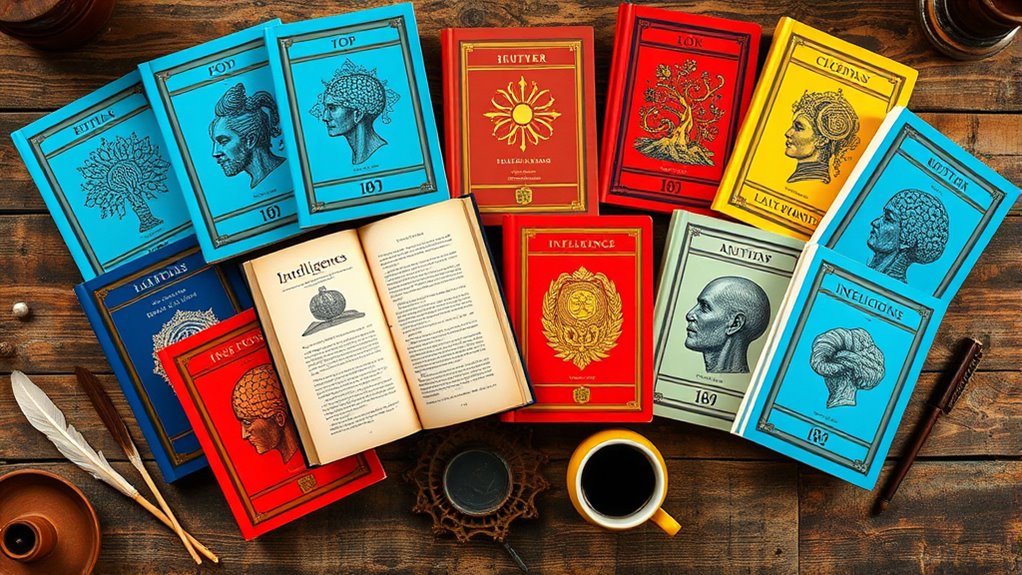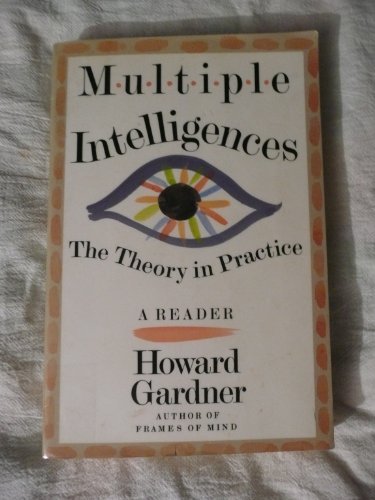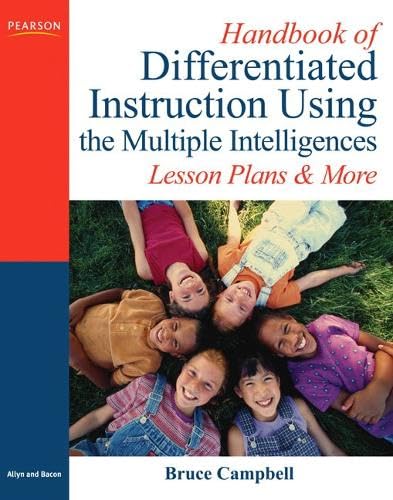If you’re looking to expand your understanding of multiple intelligences, I recommend exploring 14 top books like Gardner’s *”Frames of Mind”* and *”Multiple Intelligences in the Classroom,”* which offer foundational knowledge and classroom strategies. Other valuable titles include *”So Each May Learn”* and *”Handbook of Differentiated Instruction,”* providing practical tips to implement these ideas effectively. Keep exploring these resources, and you’ll uncover nuanced ways to recognize and develop diverse talents in yourself and others.
Key Takeaways
- The list features foundational and practical books on Howard Gardner’s Multiple Intelligences theory.
- It includes resources suitable for educators, students, and curriculum developers.
- The books explore core concepts, classroom strategies, and real-world applications of MI theory.
- Some titles address criticisms, challenges, and ways to implement MI principles effectively.
- The collection promotes personalized, inclusive learning approaches to expand cognitive and creative skills.
Multiple Intelligences: New Horizons in Theory and Practice
If you’re an educator, psychologist, or parent interested in understanding how diverse human intelligences shape learning and development, then “Multiple Intelligences: New Horizons in Theory and Practice” is a must-read. Howard Gardner introduced his theory in 1983, challenging the traditional view of intelligence by proposing at least seven separate intelligences. Over time, he expanded this list, emphasizing that these intelligences are relatively autonomous. Gardner’s work has profoundly influenced education, encouraging a move away from standardized testing toward personalized learning approaches. The book explores the origins, development, and practical implications of MI theory, offering valuable insights into fostering diverse talents and rethinking teaching strategies.
Best For: educators, psychologists, and parents seeking to understand and nurture diverse human intelligences to improve learning and development.
Pros:
- Encourages personalized teaching strategies that recognize individual strengths.
- Promotes a holistic view of intelligence beyond traditional measures.
- Fosters inclusive environments that value multiple talents and learning styles.
Cons:
- Lacks falsifiability and objective assessment methods, raising questions about scientific validity.
- Can be complex to implement effectively due to its broad and varied intelligences.
- Some critics believe it offers limited predictive power compared to other models.
Frames of Mind: The Theory of Multiple Intelligences
For educators and students enthusiastic to expand their understanding of human abilities beyond traditional IQ tests, “Frames of Mind: The Theory of Multiple Intelligences” offers a compelling foundation. Howard Gardner’s groundbreaking work challenges the idea of intelligence as a single trait, proposing instead that we possess multiple autonomous intelligences like linguistic, musical, logical-mathematical, spatial, bodily-kinesthetic, and personal intelligences. These intelligences develop uniquely in each person, influencing success and potential. The book emphasizes recognizing diverse talents and encourages supporting varied ways of learning. Despite some outdated language, Gardner’s ideas continue to inspire educators and learners to appreciate the richness of human ability and potential.
Best For: educators, students, and personal development enthusiasts seeking to understand and nurture diverse human intelligences beyond traditional IQ measures.
Pros:
- Promotes recognition of multiple intelligences, fostering inclusive educational practices.
- Encourages self-awareness and appreciation of individual strengths and talents.
- Inspires a broader view of human potential beyond conventional academic skills.
Cons:
- Some language and research in the book are outdated, requiring supplemental modern resources.
- The content can be technical or dense, which may challenge casual readers.
- Limited depth on each intelligence, prompting readers to seek more specialized texts for detailed understanding.
Multiple Intelligences in the Classroom
This book stands out as an essential resource for teachers, parents, and educators who want a clear, practical understanding of how to apply Multiple Intelligences (MI) theory in the classroom. It offers well-organized content with detailed teaching projects that demonstrate how to engage students through diverse methods. I appreciate its focus on fostering holistic development and tailoring instruction to meet varied needs. The book’s accessible style makes it easy to implement ideas immediately, enhancing student participation and learning. It’s a valuable tool for professional growth, helping educators transform their teaching approaches and create inclusive, dynamic classrooms that nurture all forms of intelligence.
Best For: educators, teachers, parents, and education students seeking practical strategies to integrate Multiple Intelligences theory into classroom settings for holistic student development.
Pros:
- Well-organized content with detailed teaching projects and practical ideas.
- Clear and accessible writing style that facilitates immediate implementation.
- Focuses on fostering inclusive, dynamic classrooms that cater to diverse student needs.
Cons:
- May require adaptation for different age groups or educational levels.
- Some readers might seek more advanced or research-based theoretical insights.
- The book’s practical focus might limit in-depth exploration of MI theory’s broader academic context.
Frames Of Mind: The Theory Of Multiple Intelligences
Anyone interested in transforming traditional views on intelligence will find “Frames of Mind: The Theory of Multiple Intelligences” particularly valuable. Howard Gardner’s groundbreaking book challenges the idea of a single IQ score, proposing instead that humans possess at least seven distinct intelligences—linguistic, musical, logical-mathematical, spatial, bodily-kinesthetic, intrapersonal, and interpersonal. Supported by neurobiology, the theory shows how different brain areas handle various skills. It encourages us to recognize and nurture diverse strengths, whether in education or personal development. This book inspires reflection on how we learn, teach, and succeed, emphasizing a more personalized, holistic understanding of human potential.
Best For: educators, parents, and individuals interested in understanding and fostering diverse human intelligences to enhance learning and personal development.
Pros:
- Offers a comprehensive, research-supported alternative to traditional IQ-based assessments.
- Encourages personalized, holistic approaches to education and development.
- Promotes recognition of multiple strengths, inspiring growth in various cognitive domains.
Cons:
- Some critics argue the theory remains somewhat conceptual with limited definitive scientific proof.
- The distinctions between intelligences can be difficult to measure objectively.
- Implementation in educational settings may require significant shifts from established standardized testing practices.
Ellie Rae Discovers Eight Ways to be SMART Book
The book “Ellie Rae Discovers Eight Ways to be SMART” stands out as an excellent resource for parents, teachers, and grandparents seeking to introduce children to the concept of multiple intelligences. Readers appreciate its beautiful illustrations and how it lights up children’s faces while raising awareness of different strengths. Many find it engaging and beneficial for helping kids recognize their unique talents. Educators use it in classrooms, and families use it at home to foster self-awareness and social skills. While some feel it leans more toward pedagogy than storytelling, overall, it’s a valuable addition to children’s literature that promotes understanding and appreciation of diverse intelligences.
Best For: parents, teachers, and grandparents seeking to introduce children to multiple intelligences and foster self-awareness and social skills.
Pros:
- Engaging and beautifully illustrated, making complex concepts accessible for children
- Supports social-emotional learning and recognition of diverse talents
- Versatile for use in classrooms and at home, enhancing understanding of individual strengths
Cons:
- Some readers find the book leans more toward pedagogy than storytelling, which may reduce engagement for some children
- Might be less suitable for very young children due to its educational focus
- Certain reviewers feel it could benefit from a stronger narrative element to complement its educational content
Multiple Intelligences: The Theory in Practice
If you’re an educator or student interested in applying multiple intelligences in real-world teaching, “Multiple Intelligences: The Theory in Practice” offers practical insights that can transform your approach. Howard Gardner’s work provides valuable strategies for accommodating diverse learning styles, emphasizing the importance of varied instructional methods. The book is praised for being accessible, insightful, and highly applicable in educational settings. It highlights how different body parts and learning forms contribute to understanding, encouraging teachers to tailor their lessons accordingly. Overall, this book is a must-read for anyone seeking to implement Gardner’s theory effectively and enhance student engagement and success.
Best For: educators, students, and educational professionals seeking practical strategies to implement multiple intelligences in teaching for more engaging and effective learning experiences.
Pros:
- Offers practical, real-world applications of Gardner’s theory to enhance teaching methods
- Accessible and insightful, suitable for both beginners and experienced educators
- Emphasizes the importance of tailoring instruction to diverse learning styles for better student engagement
Cons:
- May lack detailed step-by-step lesson plans for immediate classroom implementation
- Some readers might desire more in-depth scientific explanations of each intelligence type
- The focus is primarily on educational settings, limiting its applicability outside of classrooms
The Multiple Intelligences of Reading and Writing
For educators, parents, and students enthusiastic to enhance reading and writing skills through innovative methods, “The Multiple Intelligences of Reading and Writing: Making the Words Come Alive” stands out as a highly practical resource. This book offers creative, easy-to-understand strategies based on Howard Gardner’s theory of Multiple Intelligences. It helps children, especially in grades six through elementary school, improve literacy by engaging diverse learning styles. Teachers and parents find it invaluable for lesson planning and supporting struggling readers. Many report increased student engagement and better comprehension. Overall, it’s a compelling guide to making words come alive and fostering a love for reading and writing.
Best For: educators, parents, and students seeking innovative, engaging strategies to improve reading and writing skills, especially for those in grades six through elementary school.
Pros:
- Provides creative, easy-to-understand strategies based on Howard Gardner’s theory of Multiple Intelligences.
- Enhances student engagement and comprehension through diverse learning styles.
- Serves as a valuable resource for lesson planning and supporting struggling readers.
Cons:
- May require teachers and parents to adapt their current teaching methods to fully utilize MI-based strategies.
- Some strategies might need additional materials or resources not included in the book.
- The focus is primarily on elementary and middle school, which may limit applicability for older students.
Multiple Intelligences : The Complete MI Book
Educators seeking a thorough, practical guide to applying multiple intelligences in the classroom will find “The Complete MI Book” an invaluable resource. This detailed guide offers over 160 strategies, making it easy to implement MI principles across various educational settings. It emphasizes building on students’ strengths and creating inclusive, supportive environments. The book includes practical activities like Kagan structures that seamlessly integrate into existing lessons, boosting engagement. Whether you’re a teacher, curriculum developer, or gifted educator, this book transforms MI theory into actionable teaching tools. Despite minor printing issues, its depth and practicality make it a must-have for anyone committed to differentiated, student-centered learning.
Best For: educators, curriculum developers, and gifted educators seeking a comprehensive, practical guide to implementing multiple intelligences in diverse classroom settings.
Pros:
- Over 160 practical, easy-to-implement strategies for diverse learning environments
- Emphasizes building on students’ strengths to foster inclusive and supportive classrooms
- Incorporates cooperative structures like Kagan activities that seamlessly integrate into existing lessons
Cons:
- Some users have reported minor printing issues such as duplicated pages or missing content
- The book’s large size and extensive content may be overwhelming for some readers initially
- May require time and effort to adapt strategies effectively across different educational contexts
Intelligence Reframed: Multiple Intelligences for the 21st Century
Intelligence Reframed: Multiple Intelligences for the 21st Century is an ideal resource for readers who already have a basic understanding of Gardner’s theory and want to deepen their knowledge. This book expands on the original concepts, integrating sociology to clarify and make Gardner’s ideas more accessible. It’s well-suited for dedicated learners and Gardner enthusiasts, offering detailed insights and reflections on the theory’s implications. While some find it dense and theoretical, it’s a valuable reference for those willing to invest time. If you’re interested in the practical and academic applications of multiple intelligences, this book provides a thorough, thought-provoking exploration.
Best For: dedicated learners and Gardner enthusiasts seeking a comprehensive, in-depth understanding of multiple intelligences integrated with sociology.
Pros:
- Expands on Howard Gardner’s original theory with detailed insights and reflections.
- Clarifies complex concepts, making them more accessible for committed readers.
- Serves as a valuable academic resource for coursework and professional development.
Cons:
- Dense and heavily theoretical, which may challenge casual readers.
- Lacks extensive empirical research backing, making some aspects hypothetical.
- Can be confusing due to references to other volumes within the series, requiring careful navigation.
Multiple Intelligences in the Classroom
If you’re looking for a practical guide to applying Howard Gardner’s Multiple Intelligences theory in the classroom, this resource is an excellent choice. It offers clear strategies for identifying students’ strongest intelligences and tailoring instruction accordingly. The book translates Gardner’s complex ideas into accessible, actionable activities that engage diverse learners and foster holistic development. Teachers can immediately implement these techniques to energize their classrooms, improve management, and promote collaboration. Its well-organized structure and helpful tools make it easy to integrate MI principles into daily teaching. Ultimately, it helps create inclusive, dynamic learning environments that celebrate individual talents and boost student success.
Best For: educators seeking practical, accessible strategies to incorporate Howard Gardner’s Multiple Intelligences theory into classroom teaching to enhance student engagement and inclusivity.
Pros:
- Provides clear, actionable activities tailored to different intelligences, making implementation straightforward.
- Well-organized and easy to navigate, suitable for teachers at various education levels.
- Promotes inclusive, student-centered learning environments that celebrate individual talents.
Cons:
- Some critics find the writing style less fluid or overly technical at times.
- Concerns that MI theory could lead to labeling or stereotyping students if misapplied.
- The book focuses mainly on classroom strategies, without exploring broader philosophical or theoretical discussions.
Youre Smarter Than You Think: A Kids Guide to Multiple Intelligences
Are you looking for a kid-friendly guide that makes the concept of multiple intelligences easy to understand and apply? “You’re Smarter Than You Think: A Kids Guide to Multiple Intelligences” is an excellent choice for parents, teachers, and counselors who want to help children recognize and celebrate their unique strengths. This book clearly explains Howard Gardner’s theory, emphasizing that everyone excels in different areas beyond traditional academics. It offers practical strategies to boost confidence, foster talents, and support social-emotional growth. With engaging activities and relatable language, it encourages children to see their talents, promoting self-esteem and personalized learning.
Best For: parents, teachers, and counselors seeking an engaging, kid-friendly introduction to Howard Gardner’s theory of multiple intelligences to support personalized learning and confidence building.
Pros:
- Clear, accessible explanations suitable for children aged 8-14 and beyond
- Practical activities and strategies that promote self-awareness and social-emotional growth
- Valuable resource for educators and parents to foster talents and encourage meaningful discussions
Cons:
- May require adult guidance for younger children to fully engage with activities
- Some readers might prefer more in-depth scientific explanations of Gardner’s theory
- Limited to introductory level, so advanced learners may seek additional resources
So Each May Learn: Integrating Learning Styles and Multiple Intelligences
For educators and professionals seeking practical strategies to recognize and honor diverse learning preferences, “So Each May Learn” offers valuable insights. This book focuses on integrating learning styles and multiple intelligences, making it a useful resource for teachers, students, and families. It helps improve communication and relationships by understanding how different individuals learn best. The clear, accessible content includes real-world examples that simplify complex theories, making it practical for classroom application and personal growth. Readers appreciate its straightforward approach and practical strategies, which foster more inclusive, effective learning environments and strengthen connections beyond academics.
Best For: educators, students, and professionals seeking practical strategies to understand and support diverse learning preferences and improve communication in educational and personal settings.
Pros:
- Provides practical insights and real-world examples for easy implementation
- Enhances understanding of multiple intelligences and learning styles for diverse learners
- Improves communication and relationships beyond academic contexts
Cons:
- May require time to fully grasp and adapt strategies in busy environments
- Some concepts might need supplementary resources for deeper understanding
- Focus primarily on educational settings, less tailored for non-educational personal use
Handbook of Differentiated Instruction Using Multiple Intelligences
The “Handbook of Differentiated Instruction Using Multiple Intelligences” stands out as an essential resource for future teachers seeking practical guidance on implementing differentiation strategies. I find it incredibly useful for developing effective lesson plans and instructional methods tailored to diverse learning styles. It offers operational guidance that’s easy to apply in real classrooms, making it invaluable for building my teaching portfolio. Although it’s pricey, the detailed and extensive content justifies the investment. This book is highly regarded for its thorough approach, providing the tools I need to differentiate instruction confidently and enhance student engagement through multiple intelligences.
Best For: future educators and teachers looking for practical, comprehensive guidance on differentiated instruction using multiple intelligences to enhance student engagement and learning.
Pros:
- Provides detailed, operational guidance that’s easy to implement in classrooms
- Highly useful for developing effective lesson plans tailored to diverse learning styles
- Excellent resource for building a robust teaching portfolio and enhancing instructional methods
Cons:
- Considered very expensive, which may be a barrier for some users
- The extensive content can be overwhelming for those seeking quick-reference materials
- May require a significant time investment to fully utilize all the information provided
Multiple Intelligences Around the World
If you’re seeking a thorough way to understand how multiple intelligences are recognized and studied across different cultures, this list of the 14 best books offers valuable insights. I’ve found that exploring global perspectives reveals how diverse cultures value various intelligence types, from linguistic and logical-mathematical to naturalistic and bodily-kinesthetic skills. Modern research efforts go beyond traditional IQ measures, highlighting a richer, more inclusive view of human cognition. Additionally, the quality of printed materials, like non-glossy pages, makes reading easier and more comfortable. These resources deepen our understanding of intelligence worldwide, encouraging us to appreciate cognitive diversity in educational and cultural contexts.
Best For: educators, students, and lifelong learners interested in understanding the diverse ways intelligence is valued and studied across different cultures and contexts.
Pros:
- Highlights the importance of multiple intelligences beyond traditional IQ tests, promoting a more inclusive view of human cognition.
- Emphasizes international research efforts that reflect diverse cultural perspectives, enriching understanding of cognitive strengths.
- Notes the benefits of high-quality, non-glossy printed materials that improve reading comfort and reduce fatigue during study.
Cons:
- May require access to multiple resources or books, which could be time-consuming or costly.
- The broad scope of cultural perspectives might make it challenging to focus on specific regions or types of intelligence.
- Some content may be more theoretical, requiring additional practical applications for educators and learners.
Factors to Consider When Choosing Multiple Intelligences Books

When choosing a book on multiple intelligences, I focus on readability and clarity to guarantee the ideas are easy to grasp. I also consider whether it offers practical applications I can use, along with the credibility of its sources. Finally, I look at age suitability and the visual design to find a book that’s engaging and appropriate for my needs.
Readability and Clarity
Choosing a book on multiple intelligences that’s easy to understand can make a big difference in how much you learn. Clear, straightforward language helps break down complex ideas, making them accessible regardless of your background. Well-organized content with headings, summaries, and logical flow keeps you engaged and makes it easier to follow the material. Visual aids like charts and diagrams are invaluable—they clarify abstract concepts and support memory. Concise explanations focusing on key points prevent overload and enhance comprehension. An accessible writing style, free from excessive jargon, ensures the book remains engaging and easy to read. When selecting a book, prioritize readability and clarity to maximize your understanding and truly benefit from the rich insights into multiple intelligences.
Practical Application Focus
To effectively apply multiple intelligences theory in real-world settings, choosing books that focus on practical strategies and activities is essential. Look for resources that offer clear, step-by-step lesson plans or activities, making it easier to implement ideas immediately. It’s also helpful to select books that include assessment tools or inventories, so you can identify individual or student strengths across different intelligences. Practical examples and case studies demonstrate how to adapt teaching methods effectively, providing real-world context. Additionally, opt for materials that emphasize integrating multiple intelligences into existing curricula, ensuring smooth incorporation into daily educational routines. These features make it easier to translate theory into practice, ultimately enhancing learning experiences and outcomes.
Credibility and Sources
Ensuring the credibility of a multiple intelligences book is essential before relying on its content. I look for authors who are recognized experts in psychology, education, or Howard Gardner himself, as their endorsement adds trustworthiness. It’s important that the book cites peer-reviewed research or empirical studies, demonstrating a solid scientific foundation. I also check if the sources referenced are reputable, current, and relevant, which indicates thorough scholarship. The publisher matters too; reputable publishers with a history of producing scholarly or educational materials guarantee quality. Ultimately, I seek reviews or endorsements from educational institutions, professional organizations, or academic professionals, as these lend additional credibility. These factors help me select books that are not only insightful but also reliable.
Age and Audience Suitability
When selecting a multiple intelligences book, considering the age and developmental stage of the intended audience helps guarantee the content resonates and is understandable. For children, look for books with engaging illustrations and simple explanations that introduce multiple intelligences in an accessible way, sparking curiosity. Adolescents benefit from resources that balance basic concepts with relatable examples, encouraging deeper interest. For adults and educators, choose books that offer detailed analysis, research insights, and practical applications suited to more advanced learning levels. Matching the tone and style to the audience’s literacy skills and interests ensures better comprehension, retention, and motivation. Making certain age-appropriate content ultimately makes the learning experience more effective and enjoyable for everyone.
Visual and Layout Design
Choosing the right multiple intelligences book involves paying close attention to its visual and layout design, as these elements considerably impact how easily you can absorb the information. A clear, well-organized layout with headings, subheadings, and bullet points makes it easier to navigate and find key ideas quickly. Visual elements like charts, diagrams, and illustrations can reinforce concepts and clarify complex topics, especially for visual learners. Consistent fonts, colors, and spacing create a cohesive look that reduces eye strain and helps maintain focus. Additionally, engaging images support the text and enrich the learning experience. Simplified, uncluttered pages with adequate margins and spacing improve comprehension and make note-taking more efficient, ensuring a smoother, more effective reading journey.
Frequently Asked Questions
How Can I Apply Multiple Intelligences in My Daily Life?
To apply multiple intelligences in my daily life, I identify my strengths and incorporate them into routines. If I excel in musical intelligence, I listen to music while working. For kinesthetic intelligence, I take active breaks or walk during tasks. I also try to understand others’ strengths to communicate better and collaborate effectively. Embracing my diverse intelligences helps me learn, problem-solve, and enjoy life more fully.
Are There Specific Books for Adult Learners on Multiple Intelligences?
Absolutely, there are books tailored for adult learners interested in multiple intelligences. I recommend “Multiple Intelligences in the Classroom” by Thomas Armstrong, which is very accessible and practical. Another great read is “Multiple Intelligences: New Horizons in Theory and Practice” by Howard Gardner. These books help you understand your strengths and develop strategies to enhance your learning and personal growth, making the concept of multiple intelligences relevant and actionable for adults.
How Do Cultural Differences Influence Multiple Intelligences Theory?
Cultural differences influence multiple intelligences theory much like a tapestry, weaving diverse threads into a vibrant pattern. I see that cultural values shape how we prioritize and interpret different intelligences, affecting educational approaches and self-perception. For example, some cultures emphasize interpersonal skills, while others value logical reasoning more. Recognizing these differences helps me appreciate that intelligence isn’t one-size-fits-all and encourages me to explore varied ways of learning and understanding.
Can Multiple Intelligences Be Developed or Are They Innate?
I believe multiple intelligences can definitely be developed. While some people might have natural strengths, I’ve seen firsthand how effort, practice, and learning strategies can boost various intelligences over time. For example, I’ve improved my musical or interpersonal skills through dedication and experience. So, I think intelligence isn’t fixed; with the right environment and motivation, we can all grow and expand our abilities.
What Are the Latest Research Trends in Multiple Intelligences?
Recently, I’ve noticed research focusing on how multiple intelligences can be nurtured through targeted activities and personalized learning. Trends show a shift toward integrating brain-based studies and neuroplasticity, emphasizing that intelligence isn’t fixed but adaptable. I find this exciting because it means we can develop strengths in areas like musical or interpersonal intelligence with effort and the right environment. This approach encourages a more holistic view of human potential.
Conclusion
Exploring these books is like setting sail on a vast ocean of understanding, each wave revealing a new island of insight. As I navigate these waters, I find my mind expanding, horizons broadening with every discovery. Let’s chart our course together, embracing the diverse winds of intelligence that carry us forward. The journey through multiple intelligences isn’t just reading; it’s a voyage into the endless depths of what we’re truly capable of.
Augustus is the visionary leader and Editor-in-Chief of Personality-Test.net. With an unwavering commitment to quality and authenticity, he oversees all content, ensuring it enlightens and empowers our audience. Augustus believes deeply in the transformative power of self-awareness and is dedicated to making Personality-Test.net a beacon for those on a journey to understand themselves better.

























